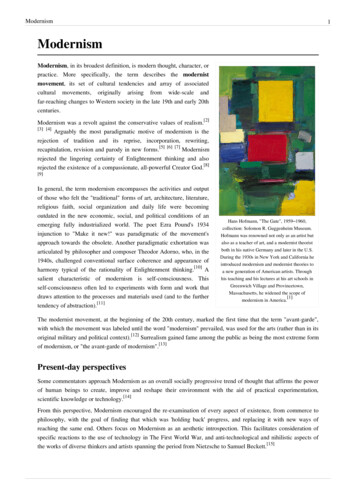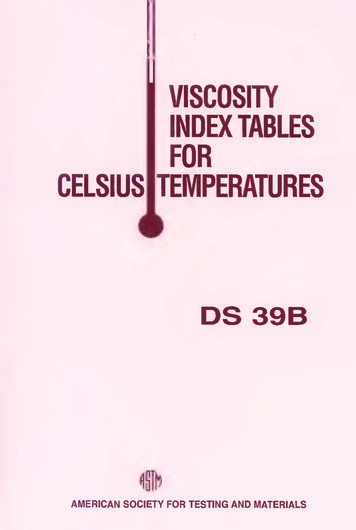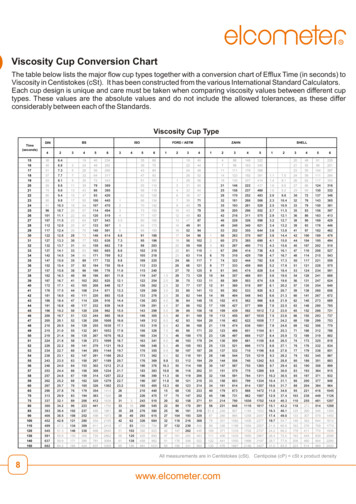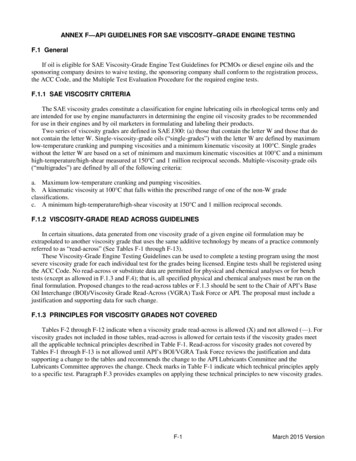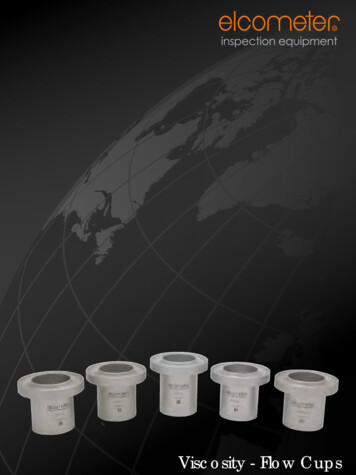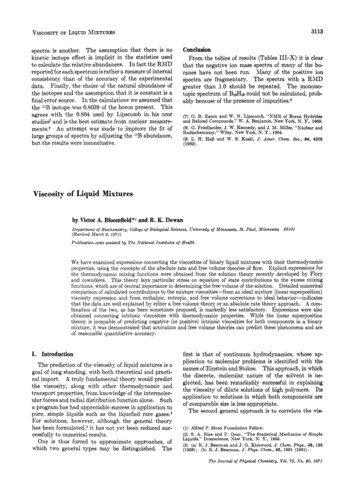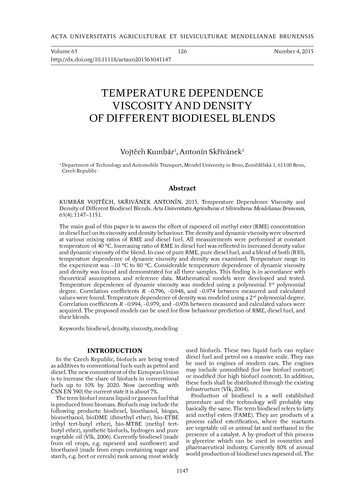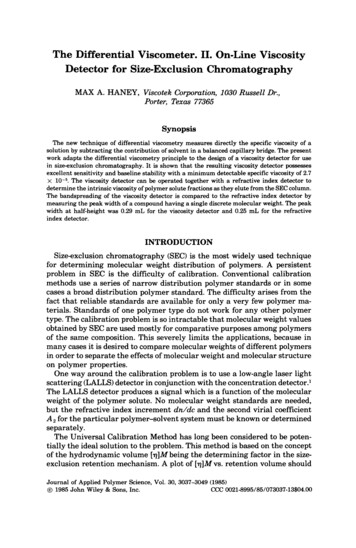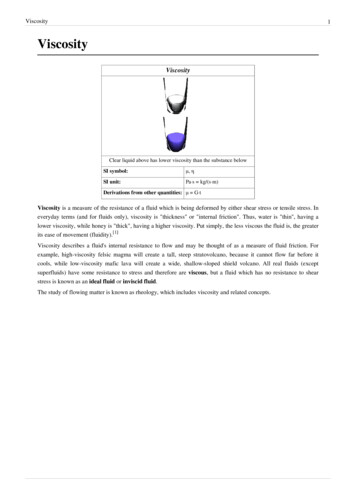
Transcription
Viscosity1ViscosityViscosityClear liquid above has lower viscosity than the substance belowSI symbol:μ, ηSI unit:Pa·s kg/(s·m)Derivations from other quantities: μ G·tViscosity is a measure of the resistance of a fluid which is being deformed by either shear stress or tensile stress. Ineveryday terms (and for fluids only), viscosity is "thickness" or "internal friction". Thus, water is "thin", having alower viscosity, while honey is "thick", having a higher viscosity. Put simply, the less viscous the fluid is, the greaterits ease of movement (fluidity).[1]Viscosity describes a fluid's internal resistance to flow and may be thought of as a measure of fluid friction. Forexample, high-viscosity felsic magma will create a tall, steep stratovolcano, because it cannot flow far before itcools, while low-viscosity mafic lava will create a wide, shallow-sloped shield volcano. All real fluids (exceptsuperfluids) have some resistance to stress and therefore are viscous, but a fluid which has no resistance to shearstress is known as an ideal fluid or inviscid fluid.The study of flowing matter is known as rheology, which includes viscosity and related concepts.
ViscosityEtymologyThe word "viscosity" derives from the Latin word "viscum alba" for mistletoe. A viscous glue called birdlime wasmade from mistletoe berries and used for lime-twigs to catch birds.[2]Properties and behaviorOverviewIn general, in any flow, layers move atdifferent velocities and the fluid'sviscosity arises from the shear stressbetween the layers that ultimatelyopposes any applied force.The relationship between the shearstress and the velocity gradient can beobtained by considering two platesclosely spaced at a distance y, andseparated by a homogeneous substance.Assuming that the plates are very large,with a large area A, such that edgeeffects may be ignored, and that thelower plate is fixed, let a force F beLaminar shear of fluid between two plates. Friction between the fluid and the movingapplied to the upper plate. If this forceboundaries causes the fluid to shear. The force required for this action is a measure ofcauses the substance between the platesthe fluid's viscosity. This type of flow is known as a Couette flow.to undergo shear flow with a velocitygradient u (as opposed to just shearingelastically until the shear stress in the substance balances the applied force), the substance is called a fluid.The applied force is proportional to the area and velocity gradient in the fluid and inversely proportional to thedistance between the plates. Combining these three relations results in the equation:2
Viscosity3Laminar shear, the non-constant gradient, is a result of the geometry the fluid is flowingthrough (e.g. a pipe).,where μ is the proportionality factor called viscosity.This equation can be expressed in terms of shear stress. Thus as expressed in differential form by IsaacNewton for straight, parallel and uniform flow, the shear stress between layers is proportional to the velocity gradientin the direction perpendicular to the layers:Hence, through this method, the relation between the shear stress and the velocity gradient can be obtained.Note that the rate of shear deformation iswhich can be also written as a shear velocity,.James Clerk Maxwell called viscosity fugitive elasticity because of the analogy that elastic deformation opposesshear stress in solids, while in viscous fluids, shear stress is opposed by rate of deformation.
Viscosity4Types of viscosityViscosity, the slope of each line, varies among materialsNewton's law of viscosity, given above, is a constitutive equation (like Hooke's law, Fick's law, Ohm's law). It is nota fundamental law of nature but an approximation that holds in some materials and fails in others. Non-Newtonianfluids exhibit a more complicated relationship between shear stress and velocity gradient than simple linearity. Thusthere exist a number of forms of viscosity: Newtonian: fluids, such as water and most gases which have a constant viscosity. Shear thickening: viscosity increases with the rate of shear. Shear thinning: viscosity decreases with the rate of shear. Shear thinning liquids are very commonly, butmisleadingly, described as thixotropic. Thixotropic: materials which become less viscous over time when shaken, agitated, or otherwise stressed. Rheopectic: materials which become more viscous over time when shaken, agitated, or otherwise stressed. A Bingham plastic is a material that behaves as a solid at low stresses but flows as a viscous fluid at highstresses. A magnetorheological fluid is a type of "smart fluid" which, when subjected to a magnetic field, greatlyincreases its apparent viscosity, to the point of becoming a viscoelastic solid.
ViscosityViscosity coefficientsViscosity coefficients can be defined in two ways: Dynamic viscosity, also absolute viscosity, the more usual one (typical units Pa·s, Poise, P); Kinematic viscosity is the dynamic viscosity divided by the density (typical units m2/s, Stokes, St).Viscosity is a tensorial quantity that can be decomposed in different ways into two independent components. Themost usual decomposition yields the following viscosity coefficients: Shear viscosity, the most important one, often referred to as simply viscosity, describing the reaction to appliedshear stress; simply put, it is the ratio between the pressure exerted on the surface of a fluid, in the lateral orhorizontal direction, to the change in velocity of the fluid as you move down in the fluid (this is what is referredto as a velocity gradient). Volume viscosity (also called bulk viscosity or second viscosity) becomes important only for such effects wherefluid compressibility is essential. Examples would include shock waves and sound propagation. It appears in theStokes' law (sound attenuation) that describes propagation of sound in Newtonian liquid.Alternatively, Extensional viscosity, a linear combination of shear and bulk viscosity, describes the reaction to elongation,widely used for characterizing polymers. For example, at room temperature, water has a dynamic shear viscosityof about 1.0 10 3 Pa·s and motor oil of about 250 10 3 Pa·s.[3]Viscosity measurementViscosity is measured with various types of viscometers and rheometers. A rheometer is used for those fluids whichcannot be defined by a single value of viscosity and therefore require more parameters to be set and measured than isthe case for a viscometer. Close temperature control of the fluid is essential to accurate measurements, particularly inmaterials like lubricants, whose viscosity can double with a change of only 5 C.For some fluids, viscosity is a constant over a wide range of shear rates (Newtonian fluids). The fluids without aconstant viscosity (non-Newtonian fluids) cannot be described by a single number. Non-Newtonian fluids exhibit avariety of different correlations between shear stress and shear rate.One of the most common instruments for measuring kinematic viscosity is the glass capillary viscometer.In paint industries, viscosity is commonly measured with a Zahn cup, in which the efflux time is determined andgiven to customers. The efflux time can also be converted to kinematic viscosities (centistokes, cSt) through theconversion equations.Also used in paint, a Stormer viscometer uses load-based rotation in order to determine viscosity. The viscosity isreported in Krebs units (KU), which are unique to Stormer viscometers.A Ford viscosity cup measures the rate of flow of a liquid. This, under ideal conditions, is proportional to thekinematic viscosity.Vibrating viscometers can also be used to measure viscosity. These models such as the Dynatrol use vibration ratherthan rotation to measure viscosity.Extensional viscosity can be measured with various rheometers that apply extensional stress.Volume viscosity can be measured with an acoustic rheometer.Apparent viscosity is a calculation derived from tests performed on drilling fluid used in oil or gas well development.These calculations and tests help engineers develop and maintain the properties of the drilling fluid to thespecifications required.5
Viscosity6UnitsDynamic viscosityThe usual symbol for dynamic viscosity used by mechanical and chemical engineers — as well as fluid dynamicists— is the Greek letter mu (μ).[4] [5] [6] The symbol η is also used by chemists, physicists, and the IUPAC.[7]The SI physical unit of dynamic viscosity is the pascal-second (Pa·s), (equivalent to N·s/m2, or kg/(m·s)). If a fluidwith a viscosity of one Pa·s is placed between two plates, and one plate is pushed sideways with a shear stress of onepascal, it moves a distance equal to the thickness of the layer between the plates in one second.The cgs physical unit for dynamic viscosity is the poise[8] (P), named after Jean Louis Marie Poiseuille. It is morecommonly expressed, particularly in ASTM standards, as centipoise (cP). Water at 20 C has a viscosity of 1.0020cP or 0.001002 kg/(m·s).1 P 1 g·cm 1·s 1.1 Pa·s 1 kg·m 1·s 1 10 P.The relation to the SI unit is1 P 0.1 Pa·s,1 cP 1 mPa·s 0.001 Pa·s.Kinematic viscosityIn many situations, we are concerned with the ratio of the inertial force to the viscous force (i.e. the Reynoldsnumber,) , the former characterized by the fluid density ρ. This ratio is characterized by thekinematic viscosity (Greek letter nu, ν), defined as follows:The SI unit of ν is m2/s. The SI unit of ρ is kg/m3.The cgs physical unit for kinematic viscosity is the stokes (St), named after George Gabriel Stokes. It is sometimesexpressed in terms of centiStokes (cSt). In U.S. usage, stoke is sometimes used as the singular form.1 St 1 cm2·s 1 10 4 m2·s 1.1 cSt 1 mm2·s 1 10 6m2·s 1.Water at 20 C has a kinematic viscosity of about 1 cSt.The kinematic viscosity is sometimes referred to as diffusivity of momentum, because it has the same unit as and iscomparable to diffusivity of heat and diffusivity of mass. It is therefore used in dimensionless numbers whichcompare the ratio of the diffusivities.FluidityThe reciprocal of viscosity is fluidity, usually symbolized by φ 1 / μ or F 1 / μ, depending on the conventionused, measured in reciprocal poise (cm·s·g 1), sometimes called the rhe. Fluidity is seldom used in engineeringpractice.The concept of fluidity can be used to determine the viscosity of an ideal solution. For two componentsthe fluidity when a and b are mixed iswhich is only slightly simpler than the equivalent equation in terms of viscosity:and,
Viscosity7where χa and χb is the mole fraction of component a and b respectively, and μa and μb are the components pureviscosities.Non-standard unitsThe Reyn is a British unit of dynamic viscosity.Viscosity index is a measure for the change of kinematic viscosity with temperature. It is used to characteriselubricating oil in the automotive industry.At one time the petroleum industry relied on measuring kinematic viscosity by means of the Saybolt viscometer, andexpressing kinematic viscosity in units of Saybolt Universal Seconds (SUS).[9] Other abbreviations such as SSU(Saybolt Seconds Universal) or SUV (Saybolt Universal Viscosity) are sometimes used. Kinematic viscosity incentistoke can be converted from SUS according to the arithmetic and the reference table provided in ASTM D2161.[10]Molecular originsThe viscosity of a system is determined by how molecules constitutingthe system interact. There are no simple but correct expressions for theviscosity of a fluid. The simplest exact expressions are theGreen–Kubo relations for the linear shear viscosity or the TransientTime Correlation Function expressions derived by Evans and Morrissin 1985. Although these expressions are each exact in order tocalculate the viscosity of a dense fluid, using these relations requiresthe use of molecular dynamics computer simulations.GasesViscosity in gases arises principally from the molecular diffusion thattransports momentum between layers of flow. The kinetic theory ofgases allows accurate prediction of the behavior of gaseous viscosity.Within the regime where the theory is applicable: Viscosity is independent of pressure and Viscosity increases as temperature increases.[12]Pitch has a viscosity approximately 230 billion[11]James Clerk Maxwell published a famous paper in 1866 using the(2.3 1011) times that of water.[13]kinetic theory of gases to study gaseous viscosity.To understandwhy the viscosity is independent of pressure, consider two adjacent boundary layers (A and B) moving with respectto each other. The internal friction (the viscosity) of the gas is determined by the probability a particle of layer Aenters layer B with a corresponding transfer of momentum. Maxwell's calculations showed him that the viscositycoefficient is proportional to both the density, the mean free path and the mean velocity of the atoms. On the otherhand, the mean free path is inversely proportional to the density. So an increase of pressure doesn't result in anychange of the viscosity.
Viscosity8Relation to mean free path of diffusing particlesIn relation to diffusion, the kinematic viscosity provides a better understanding of the behavior of mass transport of adilute species. Viscosity is related to shear stress and the rate of shear in a fluid, which illustrates its dependence onthe mean free path, λ, of the diffusing particles.From fluid mechanics, for a Newtonian fluid, the shear stress, τ, on a unit area moving parallel to itself, is found tobe proportional to the rate of change of velocity with distance perpendicular to the unit area:for a unit area parallel to the x-z plane, moving along the x axis. We will derive this formula and show how μ isrelated to λ.Interpreting shear stress as the time rate of change of momentum, p, per unit area A (rate of momentum flux) of anarbitrary control surface giveswhereis the average velocity along x of fluid molecules hitting the unit area, with respect to the unit area.Further manipulation will show[14], assuming that molecules hitting the unit area come from all distances between 0 and λ(equally distributed), and that their average velocities change linearly with distance (always true for smallenough λ). From this follows:whereis the rate of fluid mass hitting the surface,ρ is the density of the fluid,ū is the average molecular speed (),μ is the dynamic viscosity.Effect of temperature on the viscosity of a gasSutherland's formula can be used to derive the dynamic viscosity of an ideal gas as a function of the temperature:[15]This in turn is equal towhereis a constant.in Sutherland's formula: μ dynamic viscosity in (Pa·s) at input temperature T,μ0 reference viscosity in (Pa·s) at reference temperature T0,T input temperature in kelvins,T0 reference temperature in kelvins,C Sutherland's constant for the gaseous material in question.
Viscosity9Valid for temperatures between 0 T 555 K with an error due to pressure less than 10% below 3.45 MPa.Sutherland's constant and reference temperature for some gasesGasC [K]T0 [K] μ0 [μPa s]air120291.15 18.27nitrogen111300.55 17.81oxygen127292.25 20.18carbon dioxide240293.15 14.8carbon monoxide 118288.15 17.2hydrogen72293.85 8.76ammonia370293.15 9.82sulfur dioxide416293.65 12.54helium79.4[16] 27319[17]See also [18].Viscosity of a dilute gasThe Chapman-Enskog equation[19] may be used to estimate viscosity for a dilute gas. This equation is based on asemi-theoretical assumption by Chapman and Enskog. The equation requires three empirically determinedparameters: the collision diameter (σ), the maximum energy of attraction divided by the Boltzmann constant (є/к)and the collision integral (ω(T*)).with T* κT/ε — reduced temperature (dimensionless),μ0 viscosity for dilute gas (μPa.s),M molecular mass (g/mol),T temperature (K),σ the collision diameter (Å),ε / κ the maximum energy of attraction divided by the Boltzmann constant (K),ωμ the collision integral.
Viscosity10LiquidsIn liquids, the additional forces between molecules become important.This leads to an additional contribution to the shear stress though theexact mechanics of this are still controversial. Thus, in liquids: Viscosity is independent of pressure (except at very high pressure);and Viscosity tends to fall as temperature increases (for example, waterviscosity goes from 1.79 cP to 0.28 cP in the temperature rangefrom 0 C to 100 C); see temperature dependence of liquidviscosity for more details.The dynamic viscosities of liquids are typically several orders ofmagnitude higher than dynamic viscosities of gases.Viscosity of blends of liquidsThe viscosity of the blend of two or more liquids can be estimatedusing the Refutas equation[20] . The calculation is carried out in threesteps.Video showing three liquids with differentViscositiesThe first step is to calculate the Viscosity Blending Number (VBN)(also called the Viscosity Blending Index) of each component of the blend:(1)where v is the kinematic viscosity in centistokes (cSt). It is important that the kinematic viscosity of each componentof the blend be obtained at the same temperature.The next step is to calculate the VBN of the blend, using this equation:(2)where xX is the mass fraction of each component of the blend.Once the viscosity blending number of a blend has been calculated using equation (2), the final step is to determinethe kinematic viscosity of the blend by solving equation (1) for v:(3)where VBNBlend is the viscosity blending number of the blend.
Viscosity11Viscosity of selected substancesThe viscosity of air and water are by far the two most important materials for aviation aerodynamics and shippingfluid dynamics. Temperature plays the main role in determining viscosity.Viscosity of airThe viscosity of air depends mostly on the temperature. At 15.0 C, theviscosity of air is 1.78 10 5 kg/(m·s), 17.8 μPa.s or 1.78 10 5 Pa.s. One canget the viscosity of air as a function of temperature from the Gas ViscosityCalculator [21]Pressure dependence of the dynamicviscosity of dry air at the temperatures of300, 400 and 500 KViscosity of waterThe dynamic viscosity of water is 8.90 10 4 Pa·s or8.90 10 3 dyn·s/cm2 or 0.890 cP at about 25 C.Water has a viscosity of 0.0091 poise at 25 C, or 1centipoise at 20 C.As a function of temperature T (K): (Pa·s) A 10B/(T C)where A 2.414 10 5 Pa·s ; B 247.8 K ; and C 140K.Viscosity of liquid water at different temperatures up tothe normal boiling point is listed below.Dynamic Viscosity of Water
Viscosity12Temperature [ C]Viscosity 4668700.4044800.3550900.31501000.2822Viscosity of various materialsSome dynamic viscosities of Newtonian fluids are listed below:Example of the viscosity of milk and water.Liquids with higher viscosities will not makesuch a splash when poured at the same velocity.
Viscosity13Honey being drizzled.Peanut butter is a semi-solid and can thereforehold peaks.Viscosity of selected gases at 100 kPa, [μPa·s]Gasat 0 C (273 K) at 27 C (300 xenon21.223.2carbon dioxide15.0methane11.2ethane9.5
Viscosity14FluidViscosity [Pa·s]Viscosity �10,000molten glass10–1,00010,000–1,000,000chocolate syrup10–2510,000–25,000molten chocolate* –100,000peanut butter*c. 250c. 250,000shortening*c. 250250,000 Viscosity of fluids with variable compositionsViscosity of liquids at 25 CLiquid ():Viscosity [Pa·s]Viscosity [cP mPa·s][24]3.06 10 40.306[24]6.04 10 40.604(3–4) 10 33–40.9859851.38061380.6ethanol1.074 10 31.074ethylene glycol1.61 10 216.11.2 (at 20 C)12002.02220221.526 10 31.5265.44 10 40.544acetonebenzeneblood (37 C)[25][24]castor oil[24]corn ][12] 0.06565[12] 0.319319Motor oil SAE 10 (20 C)Motor oil SAE 40 (20 C)[24]nitrobenzene1.863 10 31.863liquid nitrogen @ 77K1.58 10 40.158propanol[24]1.945 10 31.945olive oil.08181pitch2.3e82.3e115e115e14sulfuric acid2.42 10 224.2water8.94 10 40.894quark–gluon plasma[24][27]
Viscosity15* These materials are highly non-Newtonian.Viscosity of solidsOn the basis that all solids such as granite[28] flow to a small extent in response to small shear stress, someresearchers[29] have contended that substances known as amorphous solids, such as glass and many polymers, maybe considered to have viscosity. This has led some to the view that solids are simply "liquids" with a very highviscosity, typically greater than 1012 Pa·s. This position is often adopted by supporters of the widely heldmisconception that glass flow can be observed in old buildings. This distortion is the result of the undeveloped glassmaking process of earlier eras, and not due to the viscosity of glass.[30]However, others argue that solids are, in general, elastic for small stresses while fluids are not.[31] Even if solids flowat higher stresses, they are characterized by their low-stress behavior. This distinction is muddled if measurementsare continued over long time periods, such as the Pitch drop experiment. Viscosity may be an appropriatecharacteristic for solids in a plastic regime. The situation becomes somewhat confused as the term viscosity issometimes used for solid materials, for example Maxwell materials, to describe the relationship between stress andthe rate of change of strain, rather than rate of shear.These distinctions may be largely resolved by considering the constitutive equations of the material in question,which take into account both its viscous and elastic behaviors. Materials for which both their viscosity and theirelasticity are important in a particular range of deformation and deformation rate are called viscoelastic. In geology,earth materials that exhibit viscous deformation at least three times greater than their elastic deformation aresometimes called rheids.Viscosity of amorphous materialsViscous flow in amorphous materials (e.g.in glasses and melts)[33] [34] [35] is athermally activated process:[32]Common glass viscosity curves.where Q is activation energy, T is temperature, R is the molar gas constant and A is approximately a constant.The viscous flow in amorphous materials is characterized by a deviation from the Arrhenius-type behavior: Qchanges from a high value QH at low temperatures (in the glassy state) to a low value QL at high temperatures (in theliquid state). Depending on this change, amorphous materials are classified as either strong when: QH QL QL or fragile when: QH QL QL.
ViscosityThe fragility of amorphous materials is numerically characterized by the Doremus’ fragility ratio:and strong material have RD 2 whereas fragile materials have RD 2.The viscosity of amorphous materials is quite exactly described by a two-exponential equation:with constants A1, A2, B, C and D related to thermodynamic parameters of joining bonds of an amorphous material.Not very far from the glass transition temperature, Tg, this equation can be approximated by aVogel-Fulcher-Tammann (VFT) equation.If the temperature is significantly lower than the glass transition temperature, T Tg, then the two-exponentialequation simplifies to an Arrhenius type equation:with:where Hd is the enthalpy of formation of broken bonds (termed configuron [36] s) and Hm is the enthalpy of theirmotion. When the temperature is less than the glass transition temperature, T Tg, the activation energy of viscosityis high because the amorphous materials are in the glassy state and most of their joining bonds are intact.If the temperature is highly above the glass transition temperature, T Tg, the two-exponential equation alsosimplifies to an Arrhenius type equation:with:When the temperature is higher than the glass transition temperature, T Tg, the activation energy of viscosity is lowbecause amorphous materials are melt and have most of their joining bonds broken which facilitates flow.Eddy viscosityIn the study of turbulence in fluids, a common practical strategy for calculation is to ignore the small-scale vortices(or eddies) in the motion and to calculate a large-scale motion with an eddy viscosity that characterizes the transportand dissipation of energy in the smaller-scale flow (see large eddy simulation). Values of eddy viscosity used inmodeling ocean circulation may be from 5x104 to 106 Pa·s depending upon the resolution of the numerical grid.The linear viscous stress tensorViscous forces in a fluid are a function of the rate at which the fluid velocity is changing over distance. The velocityat any point r is specified by the velocity field v(r). The velocity at a small distance dr from point r may be written asa Taylor series:where dv / dr is shorthand for the dyadic product of the del operator and the velocity:16
ViscosityThis is just the Jacobian of the velocity field.Viscous forces are the result of relative motion between elements of the fluid, and so are expressible as a function ofthe velocity field. In other words, the forces at r are a function of v(r) and all derivatives of v(r) at that point. In thecase of linear viscosity, the viscous force will be a function of the Jacobian tensor alone. For almost all practicalsituations, the linear approximation is sufficient.If we represent x, y, and z by indices 1, 2, and 3 respectively, the i,j component of the Jacobian may be written as i vj where i is shorthand for / xi. Note that when the first and higher derivative terms are zero, the velocity of allfluid elements is parallel, and there are no viscous forces.Any matrix may be written as the sum of an antisymmetric matrix and a symmetric matrix, and this decomposition isindependent of coordinate system, and so has physical significance. The velocity field may be approximated as:where Einstein notation is now being used in which repeated indices in a product are implicitly summed. The secondterm from the right is the asymmetric part of the first derivative term, and it represents a rigid rotation of the fluidabout r with angular velocity ω where:For such a rigid rotation, there is no change in the relative positions of the fluid elements, and so there is no viscousforce associated with this term. The remaining symmetric term is responsible for the viscous forces in the fluid.Assuming the fluid is isotropic (i.e. its properties are the same in all directions), then the most general way that thesymmetric term (the rate-of-strain tensor) can be broken down in a coordinate-independent (and therefore physicallyreal) way is as the sum of a constant tensor (the rate-of-expansion tensor) and a traceless symmetric tensor (therate-of-shear tensor):where δij is the unit tensor. The most general linear relationship between the stress tensor σ and the rate-of-straintensor is then a linear combination of these two tensors:[37]where ς is the coefficient of bulk viscosity (or "second viscosity") and μ is the coefficient of (shear) viscosity.The forces in the fluid are due to the velocities of the individual molecules. The velocity of a molecule may bethought of as the sum of the fluid velocity and the thermal velocity. The viscous stress tensor described above givesthe force due to the fluid velocity only. The force on an area element in the fluid due to the thermal velocities of themolecules is just the hydrostatic pressure. This pressure term ( p δij) must be added to the viscous stress tensor toobtain the total stress tensor for the fluid.The infinitesimal force dFi on an infinitesimal area dAi is then given by the usual relationship:17
ViscosityReferences[1] Symon, Keith (1971). Mechanics (Third ed.). Addison-Wesley. ISBN 0-201-07392-7.[2] "The Online Etymology Dictionary" (http:/ / www. etymonline. com/ index. php?term viscous). Etymonline.com. . Retrieved 2010-09-14.[3] Raymond A. Serway (1996). Physics for Scientists & Engineers (4th ed.). Saunders College Publishing. ISBN 0-03-005932-1.[4] Victor Lyle Streeter, E. Benjamin Wylie, Keith W. Bedford Fluid Mechanics, McGraw-Hill, 1998 ISBN 0070625379[5] J. P. Holman Heat Transfer, McGraw-Hill, 2002 ISBN 0071226214[6] Frank P. Incropera, David P. DeWitt, Fundamentals of Heat and Mass Transfer, Wiley, 2007 ISBN 0471457280[7] IUPAC Gold Book, Definition of (dynamic) viscosity (http:/ / goldbook. iupac. org/ D01877. html)[8] "IUPAC definition of the Poise" (http:/ / www. iupac. org/ goldbook/ P04705. pdf#search "poise iupac"). . Retrieved 2010-09-14.[9] ASTM D 2161, Page one,(2005)[10] "Quantities and Units of Viscosity" (http:/ / www. uniteasy. com/ en/ unitguide/ Viscosity. htm). Uniteasy.com. . Retrieved 2010-09-14.[11] Edgeworth,, R.; Dalton, B.J.; Parnell, T. "The pitch drop experiment" (http:/ / www. physics. uq. edu. au/ physics museum/ pitchdrop.shtml). University of Queensland. . Retrieved 2009-03-31. A copy of: European Journal of Physics (1984) pp. 198–200.[12] Glenn Elert. "The Physics Hypertextbook-Viscosity" (http:/ / physics. info/ viscosity/ ). Physics.info. . Retrieved 2010-09-14.[13] Maxwell, J. C. (1866). "On the viscosity or internal friction of air and other gases". Philosophical Transactions of the Royal Society ofLondon 156: 249–268. doi:10.1098/rstl.1866.0013.[14] Salmon, R.L. (1998). Lectures on geophysical fluid dynamics. Oxford University Press. ISBN 0195108086., pp. 23–26.[15] Alexander J. Smits, Jean-Paul Dussauge Turbulent shear layers in supersonic flow (http:/ / books. google. com/ books?id oRx6U4T8zcIC&pg PA46), Birkhäuser, 2006, ISBN 0387261400 p. 46[16] data constants for sutherland's formula (http:/ / arxiv. org/ pdf/ physics/ 0410237. pdf)[17] Viscosity of liquids and gases (http:/ / hyperphysics. phy-astr. gsu. edu/ Hbase/ tables/ viscosity. html)[18] http:/ / www. epa. gov/ EPA-AIR/ 2005/ July/ Day-13/ a11534d. htm[19] J.O. Hirshfelder, C.F. Curtis and R.B. Bird (1964). Molecular theory of gases and liquids (First ed.)
Viscosity 5 Viscosity coefficients Viscosity coefficients can be defined in two ways: Dynamic viscosity, also absolute viscosity, the more usual one (typical units Pa·s, Poise, P); Kinematic viscosity is the dynamic viscosity divided by the density (typical units m2/s, Stokes, St). Viscosity is a tensorial quantity that c

